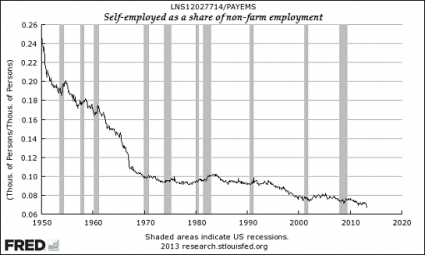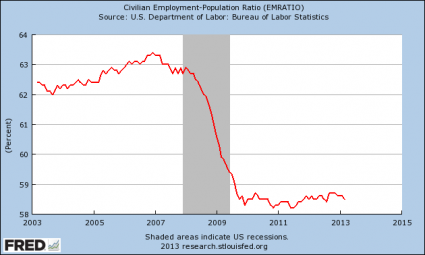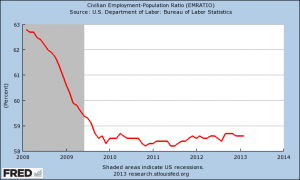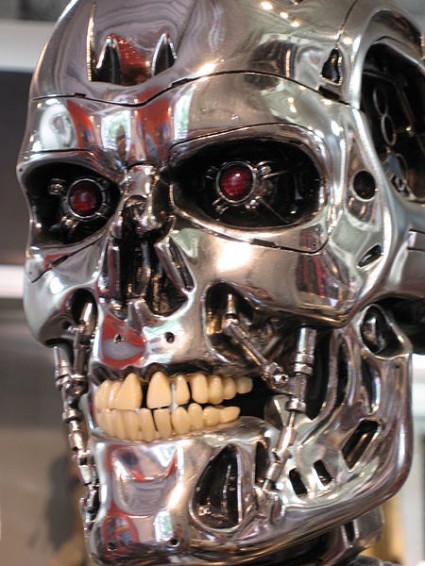 The percentage of Americans that are working for themselves has never been lower in the history of the United States. Once upon a time, the United States was a paradise for entrepreneurs and small businesses, but now the control freak bureaucrats that dominate our society have created a system that absolutely eviscerates them. This is very unfortunate, because by murdering small business, the bureaucrats are destroying the primary engine of job growth in this country. One of the big reasons why there are not enough jobs in America today is because small business creation is way down. As I mentioned yesterday, entrepreneurs and small businesses are being absolutely devastated by rules, regulations, red tape and by oppressive levels of taxation. If anyone doubts that small business in the United States is dying, just look at the charts below. Sadly, this is what the bureaucrats that run things want. They don’t want us to be independent of the system. Instead, they are much more comfortable when as many of us as possible are heavily dependent on the system in one way or another. If all of us have to go running to the government or to one of the big corporations for a job, then we are much easier to control. But as the control freaks continue to construct their bureaucratic utopia, they are also killing off what once made the U.S. economy so great.
The percentage of Americans that are working for themselves has never been lower in the history of the United States. Once upon a time, the United States was a paradise for entrepreneurs and small businesses, but now the control freak bureaucrats that dominate our society have created a system that absolutely eviscerates them. This is very unfortunate, because by murdering small business, the bureaucrats are destroying the primary engine of job growth in this country. One of the big reasons why there are not enough jobs in America today is because small business creation is way down. As I mentioned yesterday, entrepreneurs and small businesses are being absolutely devastated by rules, regulations, red tape and by oppressive levels of taxation. If anyone doubts that small business in the United States is dying, just look at the charts below. Sadly, this is what the bureaucrats that run things want. They don’t want us to be independent of the system. Instead, they are much more comfortable when as many of us as possible are heavily dependent on the system in one way or another. If all of us have to go running to the government or to one of the big corporations for a job, then we are much easier to control. But as the control freaks continue to construct their bureaucratic utopia, they are also killing off what once made the U.S. economy so great.
The other day I came across the following two charts in an article by Charles Hugh Smith, and I was absolutely stunned by what I saw. This first chart shows that the number of unincorporated self-employed Americans has dropped back to levels that we have not seen since the mid-1980s even though our population has increased by tens of millions of people since that time…
As you can see, from 1970 to the mid-1990s the number of unincorporated self-employed Americans rose steadily. But in the mid-1990s it began to level off and now it is falling rapidly.
This next chart shows the percentage of self-employed Americans as a share of non-farm employment. In other words, those that work on farms are excluded from this chart. The percentage of self-employed Americans was fairly stable between 1970 and 1990, but since 1990 it has been steadily eroding and it has now reached a level never seen before…
At this point, only about 7 percent of non-farm workers are self-employed. That is depressingly low. That means that an overwhelming majority of those that are employed in America are working for the system in one capacity or another.
But isn’t that what we pound into the heads of our children these days? We teach them to work hard in school so that they can “get a good job” when they grow up. From a very early age we train our children to plug themselves into the system.
Not that working for someone else is wrong. Of course not. It is just that we are not fostering a spirit of entrepreneurship in America today. In fact, we seem to be doing everything that we can to kill it off.
In a previous article, I detailed how the number of new businesses (and the number of jobs those businesses create) has been steadily declining. In particular, this decline has accelerated dramatically under the Obama administration. According to an analysis of U.S. Department of Labor data performed by economist Tim Kane, the following is how the decline in the number of startup jobs per 1000 Americans breaks down by presidential administration…
Bush Sr.: 11.3
Clinton: 11.2
Bush Jr.: 10.8
Obama: 7.8
Is that a good trend or a bad trend?
It doesn’t take an advanced degree in economics to figure out where things are going.
Kane speculated about why we are witnessing such a decline in his paper…
There is anecdotal evidence that the U.S. policy environment has become inadvertently hostile to entrepreneurial employment. At the federal level, high taxes and higher uncertainty about taxes are undoubtedly inhibiting entrepreneurship, but to what degree is unknown. The dominant factor may be new regulations on labor. The passage of the Affordable Care Act is creating a sweeping alteration of the regulatory environment that directly changes how employers engage their workforces, and it will be some time until those changes are understood by employers or scholars. Separately, there has been a federal crackdown since 2009 by the Internal Revenue Service on U.S. employers that hire U.S. workers as independent contractors rather than employees, raising the question of mandatory benefits. New firms tend to use part-time and contract staffing rather than full-time employees during the startup stage. According to Labor Department data, the typical American today only takes home 70 percent of compensation as pay, while the rest is absorbed by the spiraling cost of benefits (e.g., health insurance). The dilemma for U.S. policy is that an American entrepreneur has zero tax or regulatory burden when hiring a consultant/contractor who resides abroad. But that same employer is subject to paperwork, taxation, and possible IRS harassment if employing U.S.-based contractors. Finally, there has been a steady barrier erected to entrepreneurs at the local policy level. Brink Lindsey points out in his book Human Capitalism that the rise of occupational licensing is destroying startup opportunities for poor and middle class Americans.
In my previous article, I also pointed out some of the other statistics that show that small business in America is dying…
-According to the U.S. Census Bureau, the U.S. economy lost more than 220,000 small businesses during the last recession.
-As a share of the population, the percentage of Americans that are self-employed fell by more than 20 percent between 1991 and 2010.
-As a share of the population, the percentage of “new entrepreneurs and business owners” dropped by a staggering 53 percent between 1977 and 2010.
Unfortunately, this is a crisis that has taken decades to develop and that there are not any easy solutions for. But there are certain factors that should be addressed immediately. The following are some of the things that are contributing to the murder of self-employment and small business in America…
#1 Taxes: The IRS seems to especially enjoy tormenting entrepreneurs and small businesses. In fact, things have gotten so bad that even late night talk show hosts are joking about it. Recently, NBC Tonight Show host Jay Leno joked that if Barack Obama really wanted to close down Guantanamo Bay, he should “do what he always does: declare it a small business and tax it out of existence”
#2 Ridiculous Regulations: If you have ever tried to start a small business, you probably know how frustrating it can be dealing with government red tape. In particular, the federal government has burdened our small businesses with gigantic mountains of rules and regulations and it gets worse with each passing day.
#3 State Governments That Are Openly Hostile To Business: A perfect example of this is the state of California. In 2011, the state of California ranked 50th out of all 50 states in new business creation, and yet they just continue to pass more legislation that hurts small businesses.
#4 Obamacare: Our broken healthcare system is a tremendous burden on small businesses, and Obamacare is going to make things much worse.
#5 The One World Trade Agenda: In many industries, U.S. small businesses simply cannot compete against products made by workers that are being paid slave labor wages on the other side of the globe.
#6 Predator Corporations: Time after time we have seen corporate giants extract huge tax breaks and other enormous concessions from local officials which give them an overwhelming advantage. But once the corporate giant moves into town, many of the existing small businesses find that they cannot compete and are forced to shut down.
#7 Our Corrupt Political System: On the national level, elections are almost always won by the politician that raises the most money. Our politicians know that their careers depend on raising money, so they tend to be very good to those that they get big money from. There is a reason why big corporations spend billions of dollars on campaign contributions and lobbying. They do it because it works. Over the decades, the big corporations have been able to shift the rules of the game massively in their favor, and this has been to the detriment of entrepreneurs and small businesses.
Can you think of any other factors that you would add to this list? Please feel free to share your opinion by leaving a comment below…

















